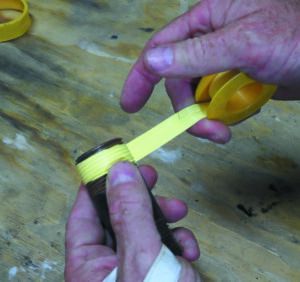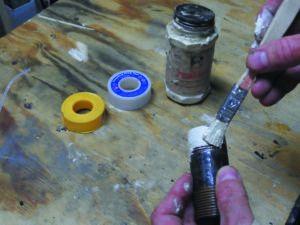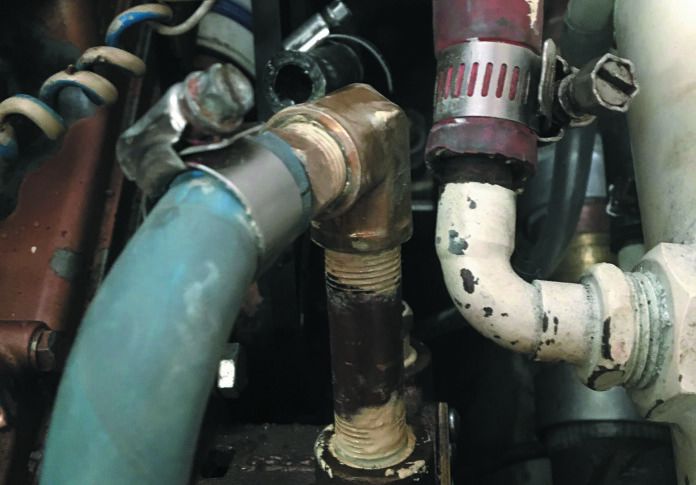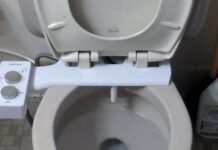After replacing the raw water pump on his 30-plus-year old Universal diesel, PS Editor Darrell Nicholson reconnected the tangle of hoses on the cooling system, fired her up and . . . drip, drip, drip. It wasn’t the lip seals on the pump that were causing the leak this time. Nor was it a gasket. Little beads of water were trickling up the new threaded elbow he’d put on the fresh water pump. It had never leaked before.
Disassembly began anew, some pipe dope was added to the threads, and the air filter and fuel lines (removed to gain access) were bolted back into place. Drip, drip, drip.
As it turns out, the problem was a common one on older plumbing fittings ranging from through hulls to sink drains to cooling pumps. The mating threads had been buggered (that is the technical term we believe). Corrosion is the common culprit, but in this case, it appeared that the brand new elbow was very poorly machined. The threads had burrs, chips, and a couple threads were flattened as if the elbow had been crimped in a vice. The lesson was learned – new does not necessarily mean new condition when you are buying plumbing fittings.
Some thread reconditioning (see PS Advisor, page 24) and some yellow Teflon tape did the trick and the engine sump was once more as dry as a bone. P
ROPER FIT UP
Sealants prevent leaks resulting from tiny fitting imperfections, but they are not intended to compensate for mismatched threads, deep scores, dirty threads, or distortions. Be sure to clean all pipe fittings using a small wire brush before every assembly and restore the threads on old fittings as needed. Dry fit any compression fittings and tapered pipes before tightening down, to confirm that they match and fit properly.
Running threads, most commonly found on mushroom thru hull fittings, do not seal well to tapered pipe threads. The pitch (threads per inch or TPI) is the same, and it might feel like they fit, but the threads on the mushroom are weak and they don’t fully engage. The result of this all-toocommon cost-cutting measure, that the thru hull might loosen and begin to wobble.
The correct solution is thread the thru hull into a flanged seacock adapter or flanged seacock and seal it with liquid pipe sealant instead of threading the valve directly onto the thru hull. Groco has a patented flanged seacock adapter (IBVF adapter) made explicitly for this purpose (www.groco.net/ products/fittings/thru-hull-fittings/ ibvf-flange-adaptor).
Examine mating fittings closely, hydraulic and boss fittings may look like pipe thread, but they often require a gasket or o-ring for proper sealing.
Hose barbs are often damaged during the removal of stubborn old hoses; hacksaws can do a lot of damage! Either replace the barb or fill the gouges with epoxy and file smooth. Thread sealants—or any sealant, for that matter— are not for hoses and generally don’t work.
SEIZING
All of the reviewed products will prevent galling and seizing due to dissimilar metals if properly applied, though Teflon seems most effective. I’ve run miles of stainless and copper in refinery settings using Teflon tape or Teflon pipe dope and never encountered a seized fitting that had been assembled using an appropriate thread sealant
Overheating and subsequent decomposition of Teflon can produce perfluoroisobutene, which is 10 times as toxic as phosgene. Inhalation of even a minute amount can be fatal. Do not use Teflon on extreme (>500F) temperature areas of exhaust manifolds, cooking appliances, or heater exhaust.
WHAT WE TESTED
We also tested popular brands of both tape and liquid sealants. Nearly all of them can be found at local hardware stores or big-box retailer. They are readily available online.
HOW WE TESTED
Ratings are based on forty years as an engineer and sometimes-pipefitter in the petroleum and industrial wastewater industries, and 35 years of boating. I’ve assembled a lot of pipes, and fought plenty of leaks on old equipment. I’ve dealt with all styles of fittings, many chemicals, lots of heat and pressure.
All of the products listed in the table are rated to 10,000 psi and at least 400F. Differences in quality and performance are too minor to quibble over, but do note set (medium vs. soft) and material compatibilities (some should not be used with PVC).
Note that we did not review gasket sealants or silicon caulks as pipe sealants. They fail way, way too often. Don’t try it.
TEFLON TAPE
Comprised of 95 percent Teflon and no adhesive, Teflon tape is clean and easy to use, compact, and has no shelf life. Several rolls (it runs out fast) belong in every tool box for those reasons. It’s handy and is very effective when properly applied to pipe up to about 1-inch in diameter. In larger sizes, pipe dopes are often more reliable. Tape allows immediate full pressure use, which is important on hydraulic systems. Dopes require curing period (typically 4 hours) for pressure over 100 psi. Because pipe dope does not set, the fittings are easier to disassemble, but they may require slightly greater torque for sealing and to resist accidental twisting.
There are several types of Teflon tape, and color designates their preferred use, but it does not mean the tape is limited explicitly to that purpose:
• White: used on NPT threads up to 3/8 inch
• Yellow: used on NPT threads 1/2- to 1.5 inch, often labeled “gas tape”
• Pink: used on NPT threads 1/2- to 1.5 inch, safe for potable water (but so are white and yellow tapes)
• Green: oil-free PTFE used on oxygen lines and some specific medical gasses
• Gray: contains nickel, anti-seizing, anti-galling and anti-corrosion, used for stainless pipes
• Copper: contains copper granules and is certified as a thread lubricant but not a sealer
You would think that more layers of white tape could do the same job, but not in my experience. It just shreds. You need the thicker tape.
Apply by winding 3-4 layers around the threads in a clockwise direction (facing the end of the pipe). Leave the last 1-2 threads bare so that the shreds of Teflon tape do not fall inside the pipe. Because pieces can shed, tape is generally considered unacceptable in hydraulic and diesel fuel systems, but with careful attention to thread ends it is safe. Excessive layers are sometimes applied to adjust the fit or to compensate for stripped threads, but this can interfere with proper sealing and reduce the pressure rating and mechanical strength.
OATLEY TEFLON TAPE
White. This is for 1/8- to 3/8-inch pipe and useable up to about 1-inch. It is thinner than other Teflon tape products and is suitable for water and all fuels.
Yellow. For 3/8- to 1 ½-inch pipe, it is thicker than white Teflon tape and is what gas inspectors want to see. This is suitable for water, all fuels, natural gas, and propane. (This is what the editor used to seal his water pump elbow.)
Pink. Similar in thickness to yellow gas tape, it is used for potable water. However, it is suitable for all fuels.
Grip Tape. Thicker than yellow gas tape, it is suitable for water, gas, and all fuels. We like it for 1.5-inch pipe, specifically in cases where we want a more robust connection than we would get if we used pipe dope.
Note: We have used tape from RectorSeal and found the performance identical to that of Oatey. Off brand tapes seem to shred more easily and sealing may not be as reliable.
PIPE DOPE (LIQUID THREAD SEALANTS)
Liquid sealants are comprised of combinations of Teflon and/or clay in a suspension based on oils and solvents. All dry to some extent, but some remain flexible and easy to remove, while others stiffen to some extent, providing added support but making removal more difficult. Loctite products belong in a separate group. It is comprised of methacrylate, which needs no oxygen to cure. Less torque is required for sealing, but these sealants create a glue-like bond making it more difficult to take apart. Many fastidious workmen swear by Loctite products for permanent installation of critical lines. Maybe a small tube for the engine room makes sense, but it has a shelf life. US pipefitters use Oatey or Rectorseal for 98 percent of their work.
Liquid dope is better than tape for straight threads because estimating the amount required is not critical, and because it flows to fill gaps. Throughhull fittings are a classic example of a straight-thread union that is best served by liquid sealant.
Apply dope by brushing at a 45-degree angle to the threads. This will fill the grooves better than brushing in the direction of the threads. Apply dope only to male threads in sizes up to 1 ¼-inch. Apply to male and female in larger sizes. I often use a cutdown ½-inch chip brush, because the brush attached to the cap can become worn-out.
A thin coating of pipe dope over compression fittings and unions adds lubrication, easing the fit-up and glossing over minute imperfections. This is mostly applicable to larger fittings (larger than 1-inch for unions and larger than 1/2-inch for compression fittings). With smaller fittings, a new compression fitting is the better answer. Teflon tape over compression fittings is generally frowned upon, but it can work pretty well in noncritical applications.
Using pipe dope to seal leaking hoses is a botched repair that will leak. Fix the barbs, position the clamps properly, and replace the hose if weathered.
Dope is generally not used on PVC or ABS threaded fittings because solvents can cause cracking; check product approvals. Plastic fittings generally require minimal lubrication and sealing, so a few wraps of Teflon tape is plenty. Dope can be used on polyethylene or nylon/Marelon fittings. Overtightening plastic fittings can lead to cracking of the female part, so tighten the parts gently.
RECTORSEAL
This is the go-to product for plumbers and pipe fitters, although, as mentioned, stating this will probably ignite the ire of the Oatey fans, and others.
RECTORSEAL NO. 5
This is probably the most popular pro product, is it the standby for most plumbing unless something else is called for. The prevalence of seawater and corrosion suggests a product with Teflon would be better for most applications, but this is still good stuff for general use onboard.
T PLUS 2
Rector’s other popular product is similar to No. 5, but is based on Teflon (PTFE). I encounter a lot of this used on refinery cooling water systems.
TRUE BLUE
This is another Teflon product but with a medium set. Popular around boilers and applications with extreme vibration.
OATEY
Most home supply stores and hardware stores stock at least one or two types of Oatey sealant. You’ll find it in the plumbing aisle, of course.
PRO DOPE
Nearly as popular as Rectorseal No. 5, this is a conventional dope with reliable performance.
GREAT WHITE
This product is comparable to Rectoreal’s Real Tuff, but at a slightly lower price point. I find it is not as effective as Real Tuff, but this could just be a personal bias.
REAL TUFF
This is my go-to product for most boat and industrial applications that are not better served by yellow Teflon tape. This has a high volume of Teflon, provides good sealing, and is easy to remove. I’ve used it on seacocks.
HERCULES BLOCK SEALANT
This is similar to True Blue, and one of my best contractors swears by it for boiler work, and I’ve got to agree with him. Specifically, it seals old rusted fittings subject to vibration and extreme temperature cycling better than soft set sealants. But you’ll need a long wrench to get it loose.
LOCTITE 575 AND 567
These products are expensive and add some locking to the joint. I’ve only seen them used on hydraulic systems.Both are medium set and both are harder to remove after setting, making them less preferable for many applications. They are slightly thinner and require a better fit for good sealing.
PERMATEX
Although the editor has used a variety of Permatex products for sealing water pumps, exhaust flanges, and other components, I have less experience with these.
PIPE JOINT COMPOUND 80045
Much like RectorSeal No.5, this is a conventional sealant with a solid reputation.
THREAD SEALANT WITH PTFE 80633
This is a Teflon soft set sealant. It is comparable to Oatey Real Tuff.
CONCLUSIONS
You need several products. Yellow or pink Teflon tape is perfect for smaller stuff and handy to keep in the tool box. Soft set liquid sealant can be better for older fittings with worn threads. Reserve medium set dope for things you don’t ever plan to remove, and only for places with room for a big wrench.
A thread restoring file is a life saver when a seacock thread or engine bolt gets buggered up, or even when rebedding a deck full of fasteners that are clogged with sealant. Combined with a wire brush, a set of taps, and some diligence, you can solve most thread problems.
| BRAND | MODEL | CONTAINS TEFLON | COLOR | SET | PROPANE/ GASOLINE/ FUEL | PVC/ CPVC/ ABS | NYLON/ MARELON/ METALS | SIZE | PRICE/ OUNCE | PRICE |
|---|---|---|---|---|---|---|---|---|---|---|
| RECTORSEAL | No. 5 | No | Yellow | Soft | Yes | No | Yes | 4 oz. | $2 | $8 |
| RECTORSEAL | T plus 2 | Yes | White | Soft | Yes | Yes | Yes | 4 oz. | $2.75 | $11 |
| RECTORSEAL | True Blue | Yes | Blue | Medium | Yes | Yes | Yes | 4 oz. | $1.75 | $7 |
| OATLEY | Pro Dope | No | Gray | Soft | Yes | Yes | Yes | 4 oz. | $1.50 | $6 |
| OATLEY | Great White | Yes | White | Soft | Yes | Yes | Yes | 4 oz. | $1.75 | $7 |
| OATLEY | Real Tuff | Yes | White | Soft | Yes | Yes | Yes | 4 oz. | $2 | $8 |
| OATLEY | Block | Yes | Blue | Medium | Yes | Yes | Yes | 4 oz. | $2 | $8 |
| LOCTITE | 575 | No | White | Medium | Yes | Yes | Yes | 8 oz. | $7.88 | $63 |
| LOCTITE | 567 | Yes | Off white | Medium | Yes | Yes | Yes | 8 oz. | $9.50 | $76 |
| PERMATEX | Pipe Joint Compound 80045 | No | Black | Soft | Yes | No | Yes | 16 oz. | $0.53 | $8.50 |
| PERMATEX | Thread Sealant with PTFE 80633 | Yes | White | Soft | Yes | No | Yes | 16 oz. | $0.96 | $15.40 |
There are as many options for sealing pipe threads as there are pipefitters. And every pipefitter has their favorite sealant. Like boxers vs. briefs, we’re not going to attempt to persuade anybody with a settled opinion. We can compare strengths and weakness, and describe the differences in application so that you can make up your own mind which works best for you. There is no single product that applies to every situation, and most pros use several types, according to the application.

1. Apply tape by winding 3-4 layers around the threads in a clockwise direction (facing the end of the pipe). Leave the last 1-2 threads bare so that the shreds of Teflon tape do not fall inside the pipe.

2. Apply pipe dope by brushing at a 45-degree angle to the threads; this will fill the grooves better than brushing in the direction of the threads.
RECTORSEAL,
OATEY,
PERMATEX,
LOCTITE,







































The article uses the name “Oatley” but it is Oatey, the name and link (there is a spare “space” %20, character in the link preventing it from working) is correct in the contacts section of the print and online article.
It is my experience that threads degrade. Time and tide are a bugger. I have seen this on boats and ships, of course, but on antique cars and Museum relics such as rail cars too. I replace with new whenever I can, and this goes for nuts and bolts as well as fittings
For cleaning female threads- especially on small fittings- I found that a 22 cal. bore cleaning brush works very well and doesn’t take up much room on my toolbox. (It is hard on the hands unless you can find/make a threaded handle for the brush). I also use a home-made pick made from a sail needle (triangular cross-section) set in a wooden handle.
My understanding is that teflon tape and pipe dope should be thought of primarily as a lubricant for threading pipe and fittings.( I too have experience as a master plumber, a pipefitter and as a licensed engineer in commercial and petrochemical plants.) Properly cut threads on pipe and fittings will seal themselves if they can engage with the help of lubricant to overcome friction. The secondary function of those products is to assist in sealing if the threads are not cut correctly or are worn from reuse.
I keep teflon paste on board my 31 as well as some tape. But for exhaust piping and its engine gasket, I use “Never Seize” that is lightly brushed on the threads. It withstands very high temperatures and is an excellent lubricant.
Drew is certainly correct that threads can be damaged or cut wrongly at the factory. Avoid products from foreign countries that have poorly-enforced quality control standards. Sometimes chasing the thread with a tap or die helps but if threads are cut too deep, the joint will likely leak and should be rejected.
When assembling a proper threaded joint, one should be able to turn the fitting 3-3 1/4 turns by hand before needing a wrenches.
This is a symptom of people having to accept low cost crap. Engineering stuff to fail so you have to buy it over and over.
Sadly a Canadian engineers concept from the 1970’s. He worked for a train locomotive manufacturer in London Ontario. He said we are building stuff too well. We need to build it to break so we can sell more parts.
One of the few things I am not proud of my country.
Cheers Rob Legate
You would think that after all this time more modern fittings would be available! We’re still using fittings from the 40’s 🤔 Some one will become a $$$$$$ air ,let’s get going !
Very good article. In my old business in the offshore oil industry, we used the two Loctite sealants in preference to PTFE thread tapes for corrosion protection as much as anything. We found that when joining screw thread fittings for use with salt water, especially when joining dis-similar metals (stainless to galvanised, or stainless to alloy) that after a short while with thread tape, the joints would seize and become wedded for life. The Loctite sealants would allow dis-assembly months or years later.
Be careful when using the word “buggered”. It is an English European term meaning sodomised (which explains its use here) and although I confess we use the term a lot in the marine survey industry, it sometimes causes offense amongst the more straight laced.
Cheers
Al
I asked my engine mechanic what to use on my Westerbeke Diesel engine’s heat exchanger Zinc when you change it every 90 days. He suggested a Teflon paste he said because the zinc and the heater changer or just similar metals. It keeps corrosion to a minimum.
Now, after reading your excellent article, I wonder about using teflon paste at all on the zinc, because of the temperatures involved.
I am not sure if the exhaust and heat exchanger reach 500 degrees I’m worried about toxic emissions from the heated Teflon. The engine heat exchanger is actually in the aft cabin that I sleep in.
What is the best paste to safely use for high temperature applications like the heat exchanger Zinc?
Specifically, What is the best paste to safely use for high temperature applications like the heat exchanger Zinc?
Specifically, What is the best paste to safely use for high temperature applications like the heat exchanger Zinc?
This is not a duplicate comment.
It’s my understanding NOT to use a thread sealant for heat exchanger anode (zinc). A metal to metal electrical connection is desired for the anode (zinc) to function most effectively.
I’ve spent the last 40 years working as a pipefitter and have found that in most applications a layer of Teflon tape followed by a thin coat of Rectorseal #5 is almost foolproof. Also regarding unions, the seal is made at the mating surface and not at threads. A little neversieze on the threads combined with a light coating of pipe dope on the sealing surface takes care of most leaks. The neversieze eliminates some of the friction and allows the union to be tightened slightly more and also makes for easier disassembly when needed.
Don’t use thread sealant on heat exchanger anodes! It will electrically insulate the anode from the heat exchanger and render it useless! I speak from the experience of having galvanic damage occur because I made this mistake!
Thank you for the engine zinc answer. It make’s good sense.